Pompeian Manufacturing Company
In 1901, Fred W. Stecher registered the name Pompeian Massage Cream and Skin Food for a cream he had spent many months formulating. By the end of the decade Pompeian Massage Cream, as it came to be known, was the best-selling face cream in the United States.
Fred W. Stecher
Stecher graduated as a pharmacist in 1887 and, after holding positions with a number of drug companies, moved to Cleveland to take a half-share in his brother’s pharmacy business in 1892. The pharmacy supplied a number of barber shops in Cleveland and it seems that Pompeian Massage Cream was developed as a side-line for sale to them. However, what began as an after-shave cream soon became the core of a new business venture.
By 1900, Stecher had acquired his brother’s share of the pharmacy business but sales of Pompeian Massage Cream were so good that he closed the pharmacy in 1906 and opened the newly incorporated Pompeian Manufacturing Company in larger premises downtown on Fourth Street. Advertising had helped. Starting in August 1929 with two advertisements in ‘Munsey’s’ and the ‘Delineator’ at a cost of US$229 his advertising budget would reach a quarter of a million dollars by 1907.
Pompeian Massage Cream
Stecher’s Pompeian Massage Cream was a casein-based rolling cream that contained benzaldehyde (artificial almond oil). It was coloured bright pink, probably with carmine, and was preserved with benzoic acid. The cream was pressure sensitive. After a shave the face was wiped clean with a towel and then Pompeian Massage Cream was rubbed in and then rubbed off taking any remaining soap and loose skin cells with it. The exfoliating action may have reduced skin irritation by removing any soap left on the skin and also decreased the likelihood of ingrown hairs.

Above: 1907 Pompeian Massage Cream.
See also: Rolling Creams
Casein was a milk protein so Stecher labelled Pompeian Massage Cream as a ‘skin food’, a not illogical practice for the time. Back then, the skin was thought to be more porous than we know it to be today. Consequently, many believed that the skin could be ‘fed’ externally by applying a cream.
See also: Skin Foods
In 1909, the words ‘Skin Food’ quietly disappeared from the Pompeian Massage Cream label and the cream was then mainly promoted as a cleanser that removed material that soap could not get to.
Get All the Dirt Out of Your Skin.
There is a great deal of difference between getting some of the dirt off and getting all of the dirt out. Washing will take off surface dirt. Only massage with Pompeian Massage Cream will take out the dirt that is in the pores—below the surface. It’s this pore-dirt that is most necessary to remove, because that is the cause of blackheads, bad complexions and unhealthy skin.
To prove how washing leaves the pore-dirt in, and just how Pompeian Massage Cream gets it out, wash your hands as thoroughly as you can with soap and water, then rub a little of the cream on the back of your hand. Rub it in well, then keep on rubbing till it comes out—that tells the story better than words.(Pompeian Massage Cream advertisement, 1906)
Like other casein rolling creams, Pompeian Massage Cream had a couple of limitations. First, it needed to be rolled off by hand, which meant that mechanical massaging devices could not be used with it. This meant that barbers who invested in electrical massage machines for use in scalp and face massage treatments would be less likely to use it. Pompeian realised this and in their advertising recommended that men insist on a hand massage.
Some barbers have “massage machines” with which a sort of grease must be used. When you get a massage in a barber shop, always tell the barber that you want a hand-massage with Pompeian Massage Cream. Machines cannot duplicate the movements of hand massage, nor can any greasy imitations duplicate the properties of the genuine Pompeian Massage Cream which contains no oil or grease of any kind.
(Pompeian Massage Cream advertisement, 1907)
Second, the cream worked best if the face was clean. As it was an after-shave cream this was not generally an issue as long as barbers made sure that the face was relatively dry when they removed the remaining lather with a towel.
By accident or design, women also used the cream – the pink colouring may have left a touch of colour on the skin that women could have found attractive. Soon it was being sold in two forms, a screw-top jar for barbers and a more feminine jar with a glass stopper for home use.
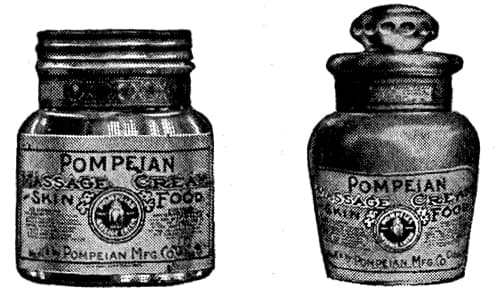
Above: 1907 Pompeian Massage Cream and Skin Food. Barber’s jar (left), home use jar (right).
Quick to capitalise on this potentially lucrative market, Pompeian was soon aiming its growing advertising budget at women as well. As advertising for the cream developed between 1901 and 1910 the screw-top jar largely disappeared from view reflecting the fact that the bulk of the sales (over 10,000 jars per day) were for personal use.
When marketed to women the claims made for Pompeian Massage Cream now included: that it would ‘reduce wrinkles and crow’s feet’; ‘smooth the complexion’; help ‘keep skin, muscles and blood-vessels in a healthy, natural condition, which resists the imprints of time, work, worry and care’; and was ‘grease free’ so it would not ‘clog pores’ or ‘grow hair’. Like many other creams sold before the First World War it was said to be better than rouge or ‘paints’ as it gave the skin a ‘natural rosy glow’.
Beauty is natural—to be otherwise is opposed to the way Nature intended every woman to be and remain. Pompeian simply makes and keeps you natural. By cleansing the internal parts of the skin it improves the complexion and imparts a natural, glorious, rosy glow.
Pompeian is not a “cold” or “grease” cream, it is not a rouge or cosmetic, and positively cannot grow hair on the face. Pompeian simply affords a natural means toward a complete cleanliness of the facial pores. And in pores that are “Pompeian clean” lies skin health. For a clean, fresh, youthful complexion, use Pompeian. Young folks keep young—use Pompeian. Other folks grow young—use Pompeian.(Pompeian Massage Cream advertisement, 1911)
If there were any benefits to be gained from using Pompeian Massage Cream most of them were probably due to the massage routine and the accompanying exfoliation that occurred as the cream was removed from the face. Although we would now consider them exaggerated, the claims were not overly inflated when compared to those made for other face creams of the time.
Otto F. Leopold
In 1916, Fred Stecher died of heart disease after a long illness and was replaced as head of the company by Otto Leopold. Otto had been in charge of sales for some time and almost immediately branched out in new directions. The company had introduced Pompeian Night Cream (a cold cream) in 1915 and in the following year Leopold added Pompeian Hair Massage to the product line. Pompeian had purchased the Cleveland-based Hyki Company who sold Hyki Tonic. Rebadged as Pompeian Hair Massage it contained alcohol, arsenic, borax, quinine and capsicum and was supposed to stop dandruff and hair loss. Leopold added other products in quick succession so, by 1920, the company had a small but relatively complete cosmetics line; the notable exception being eye cosmetics like eyeshadow or mascara.
Products
The Pompeian product range included the following:
Pompeian Massage Cream: “Brings skin health minus pimples, blackheads, etc. Easy to use—rub it in, rub it out. Stimulates facial circulation, bringing the glow of healthy color to your skin. Safe, harmless and efficient. All men should use it after shaving.”
Pompeian Hair Massage: “Makes the hair healthy and beautiful. It is a clear amber liquid. Not oily. Cannot discolor the hair. Falling hair is often caused by neglected Dandruff or Itching Scalp. Don’t wait until it is too late.”
Pompeian Day Cream (Vanishing): “It softens the skin and forms an excellent powder base.”
Pompeian Beauty Powder: “It makes the skin beautifully fair and adds a charm of delicate fragrance.” Shades: Flesh, Naturelle (1922), Rachel (originally Brunette), and White.
Pompeian Bloom (Rouge): “A rouge that is comparable when properly applied. Do you know that a touch of color in the cheeks makes the eyes sparkle with new beauty?” Shades: Light, Dark, Medium, Orange (1924), and Oriental (1926).
Pompeian Night Cream (Cold Cream): “Soothes and softens the skin. Brings beauty while you sleep. Use it nightly. Particularly needed by dry skins. It can also be used as a cleansing cold cream.”
Pompeian Lip Stick: “Makes beautiful, firm and youthful looking lips. Prevents chapped lips. Each Pompeian Lip Stick has a chisel point. Delicately perfumed. Color stays on unusually long.” Shades: Rose Petal, and Untinted.
Pompeian Fragrance (Talcum Powder): “Everyone will find this talc most delightful. Delicately perfumed and made of only the highest grade talc. You will find it bringing comfort to your tired overheated body. Men will find it gives a soothing finishing touch to their shaves.”
Pompeian Toilet Water
Pompeian Perfume
Pompeian was now in the make-up business so disparaging references to ‘grease’, ‘powders’, ‘paints’ and ‘make-up’ ceased. The original massage cream was now out on a limb, as there was no easy way to integrate it with the other skin care products. Consequently, it was often dropped from advertising aimed at women.
Advertising
The new cosmetic range required a few other adjustments. After 1916, advertising shifted from newspapers to women’s magazines such as ‘The Ladies Home Journal’, ‘Good Housekeeping’, ‘The American Magazine’, ‘Harper’s Magazine’, and ‘McCall’s Magazine’. Although more expensive this allowed the company to target women using coloured pictures in a format specifically designed for them.
As well as promotion, advertising in women’s magazines also enabled the company to provide women with advice on how Pompeian products were to be used and coordinated with each other. Many women in the 1920s were new to cosmetics, so this was welcome advice.
How to apply your rouge
Having selected your shade of Pompeian Bloom, and found the complementing shade of Pompeian Beauty Powder, your attention should be centered on the necessity of “How to apply it so that it looks completely natural.”
The color in your cheeks forms an area that is somewhat triangular in shape. It begins at the highest point in your cheekbone and sweeps outward toward the upper line of your ears, then slanting downward it approaches the corners of your mouth. But never with hard lines! Never with any circumscribed rule of covering cheeks—rather with perfect blending of rosy cheeks with clear skin.(Pompeian Bloom advertisement, 1924)
Some common cosmetic questions of the day were also covered, including how to care for dry or oily skin, how to make the skin more youthful looking, how to care for the skin across seasons and how to diagnose personal skin tones and select the right shade of cosmetic to suit it.
Today women everywhere realize the necessity of using rouge that matches perfectly their natural skin-tones. And when they use the right shade of Bloom the wholly natural effect is achieved.
From the shade chart you can easily select the particular shade of Pompeian Bloom for your type of complexion.(Pompeian Bloom advertisement, 1924)
In 1923, Pompeian began including advice offered by ‘Madame Jeanette, Specialiste en Beauté’ in their advertising. She was almost certainly an invention but was described as being a “Famous cosmetician, retained by the Pompeian Laboratories as a consultant to give authentic advice regarding the care of skin and the proper use of beauty preparations”. The invention may have been a reaction to the increasing competition Pompeian was facing from companies run by women, such as Elizabeth Arden, Helena Rubinstein and Dorothy Gray, but may simply have been driven by the need for Pompeian to provide more detailed advice on the use of its products. As well as samples you could also write away for her booklet ‘Your Type of Beauty’.
Also see the company booklet: Quel est votre type de beauté?
Art panels
In the early years of its development Pompeian had experimented with a number of promotional ideas. In the 1900s customers could send in a coupon for a sample jar of Pompeian Massage Cream and an illustrated booklet on Facial Massage. If they enclosed 6 cents worth of stamps they would also receive a song sheet they could use on their piano or later a library slip that could be collected with others to earn magazines or books. In 1910, these marketing ideas were dropped in preference to poster-calendars. For 10 cents in coin or stamps a customer could purchase a large (3 feet tall by 7¼ inches wide) poster-calendar with an full colour art picture of a ‘Pompeian Beauty’ on the front with a calendar and product information on the back. These could be hung on the wall and were very popular. In 1917, Pompeian took this idea one step forward and included a picture of the movie star Mary Pickford as the Pompeian Beauty for that year. In the 1920s the ‘Beauty Panels’, as they came to be called, were used in competitions where contestants sent in suggested titles.
Nymfaun
In 1923, Pompeian introduced an entirely new range of cosmetics under the brand name Nymfaun and established the Nymfaun Company to produce it. The product packaging had an Art Nouveau feel with nymphs and fauns in the artwork. Included in the line were loose powders, compacts, cold and vanishing creams, rouge, and lipstick with many items fragranced with the new Nymfaun perfume.
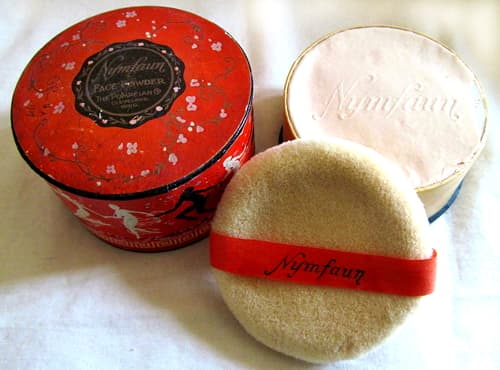
Above: Nymfaun Face Powder. Shades: Natural, Rachel, and Blanche.
You’ll surely want a box of Poudre Nymfaun for home use. Its faint delicious perfume brings dreams of southern France. Its rare consistency gives a soft, velvety finish to your skin. It adheres for hours. A fresh, new lambswool puff comes with each box. And such a delightful box! Around the side go nymph and faun in merry dance “midst” trailing vines of gold.
(Nymfaun advertisement, 1924)
Nymfaun was probably developed as a more upmarket product line for department stores. It does not appear to have been successful as advertising quickly declined, and the line was discounted. In 1926, the company Nymfaun, Inc., was sold to Storfer Laboratories. It was recapitalised in 1927 but appears to have disappeared around 1931 when economic conditions were bad.
Corporate acquisition
Following the sale on Nymfaun, Pompeian itself was sold to Colgate & Company in 1927. The purchase was one of many cosmetic company sales that occurred in the economic boom of the 1920s. Dorothy Gray and the American part of Helena Rubinstein were also sold during this time. Why the company decided to sell is an unanswered question. Increasing competition and the sale of the Nymfaun line may have been contributing factors but perhaps Otto Leopold was ready to retire and the offer was too good to refuse.
Pompeian was a successful concern for Colgate. Sales to the end of 1927 had amounted to US$1,672,066, generating a profit of US$220,040, and these rose to US$2,122,255 by the end of 1928 with a profit of US$570,382. However, after Colgate’s amalgamation with Palmolive-Peet in 1928 the new company, Colgate-Palmolive-Peet, sold Pompeian for US$1,375,000, in 1930.
See also: Colgate and Colgate-Palmolive-Peet
The new owners consisted of Harold F. Ritchie [1881-1933] (27½%), the owner of International Proprietaries Ltd., Canada; Floyd M. Shoemaker [1872-1952], who represented the Shoemaker family, the owners of the Frostilla Company (27½%); and Jacob F. Schoellkopf, Jr. [1858-1942], acting on the behalf of the Niagara Share Corporation (45%). Harold Ritchie’s companies had been the distribution agents for Pompeian and Frostilla so he was well acquainted with both.
Items on sale by Pompeian at the time of the sale included: Pompeian Beauty Powder in White, Flesh-Pink, Rachel, Nude, Naturelle, and Summer Tan shades; Pompeian Bloom in Light, Medium, Dark, Oriental, and Orange shades; Pompeian Lipstick in Light, Medium, and Dark shades; Pompeian Massage Cream; Pompeian Day Cream; Pompeian Night Cream; and Pompeian Fragrance (Talcum).
The new owners updated the Pompeian packaging.

Above: New Pompeian packaging.
The also added a professional line sold only to beauty parlours consisting of Pompeian Toning Lotion, Pompeian Cleansing Cream, Pompeian Astringent Cream, Pompeian Tissue Cream and Pompeian Face Powder.
In 1935, in the face of declining sales, the company took the dramatic action of scrapping the entire range – with the exception of Pompeian Massage Cream – with dealers allowed to return old stock in exchange for new. The new range, packaged in brighter more eye-catching colours, consisted of a face powder in four shades; a tissue, liquefying and cleansing cream; an astringent; a lipstick and a dry and a cream rouge, each in three shades. Like others in the 1930s the company also introduced a 10¢-sized face powder known as a ‘travel-size’ (Adkins, 1935).

Above: New packaging developed by J. L. Tobey from Pompeian and J. B. Richardson of W. C. Ritchie & Co. It featured black packaging with a red sphere like the sun on which were placed columns characteristic of Pompeii.
Pompeian Beauty Powder: “[R]emarkably adherent and clings without clogging the tiniest pores because of its extreme finess.” Shades: Naturelle-Nude, Peach, Rachel No. 1, and Rachel No. 2.
Pompeian Cream Rouge: “[A]ccentuates nature’s own coloring, comes in flattering tones to blend with eyes, hair and skin. It is creamy smooth, like the finest skin texture, and imparts such a rare loveliness.” Shades: Flame, Poppy, and Raspberry.
Pompeian Dry Rouge: “[S]oft as velvet, blends magnificently, enduring, flattering shades.” Shades: Flame, Poppy, and Raspberry.
Pompeian Lipstick: “[I]n three perfect shades to harmonize with your rouge and powder … will give your lips a superb lustre and an excitingly dangerous allure. Never drying—beautifully permanent—velvety smooth.” Shades: Flame, Poppy, and Raspberry.
Pompeian Cleansing Cream: “A ‘triple whip cream’ it cleans, nourishes, heals and glorifies. It transforms your skin into a miracle of velvety smoothness and youthfulness. Use it as an all-purpose cream. Use it daily to keep the skin young and fresh. ‘A dry skin today is a wrinkled skin tomorrow‘.”
Pompeian Liquefying Cream: “[M]elts quickly, yet maintains its ‘body’. It is prepared of the finest mineral oils, emulsifies easily, removing all make-up and dirt and offering no resistance to the face.”
Pompeian Tissue Cream: “This cream contains an exclusive highly penetrating Viennese property (never before used in cosmetics) that seeps deeply into the tissues and lifts the drawn tired look from your face. Used daily, it does glorious things to dry skin, lines and wrinkles.”
Pompeian Astringent and Skin Toner: “[U]se this soothing, exhilarating lotion delight that will remove all oiliness, restore firmness to your tired skin, close pores, refresh, stimulate and tighten skin.”
Also see the company booklet: Face Facts (c.1935)
The company stressed the purity of its products and their avoidance of ‘beauty-destroying chemicals’ such as bismuth, zinc oxide, zinc chloride, chalk, orris root, arsenic, leads, starch, glycerine, borax, alum, or zinc sulphate. These they suggested were the cause of ‘Dermerosion’ which they defined as ‘the progressive degrading of skin texture produced by harmful chemicals in cosmetics’, i.e. dermal erosion! This was a classic scare campaign as the list was made up of chemicals not normally found in cosmetics of the time or with substances that were perfectly harmless. Dermerosion and a number of other claims Pompeian made for the products in its new range invoked a cease and desist order from the Federal Trade Commission (FTC) in 1936.
On a more positive note they produced a ‘Get Acquainted Kit’ (costing 10¢) made up of a selection of powders and creams that people could write away for. They also advertised their new line widely through radio and print.
Other developments
In February, 1933, Harold Richie died suddenly in the Toronto General Hospital during an operation. His death and the lacklustre results from the 1935 changes saw Pompeian sold to Laco Products in 1937. Laco appears to have been primarily interested in the original massage cream which they renamed Pompeian Milk Massage Cream.
In Britain, Eno Proprietaries Ltd., the makers of Eno Fruit Salts, a Harold F. Ritchie company that had taken over the sale and distribution of Pompeian products in the United Kingdom and parts of the Commonwealth in 1930, set up The Pompeian Co. Ltd. (P.C.) with a capital of £15,000 in 1937.
In 1938, this new British company introduced new shades of Pompeian Lipsticks (Hollywood, Blondette, Geranium, and Brunetta), Rouge (Hollywood, Blondette, and Blush) and Beauty Powder (Natural, Honey Rose, Peach, Rachel, Brunette, and Sun Rose). I have no records that these new shades were also sold by Laco Products in the United States but it seems likely.
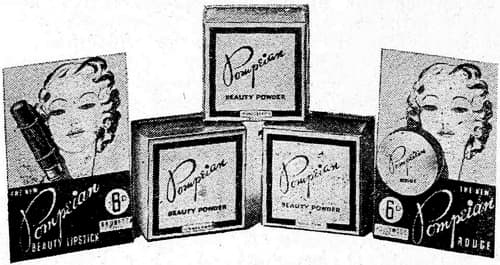
Above: 1938 Product display for Pompeian lipsticks, rouge and face powder (Britain).
The new lines were also packaged in more somber tones, returning to the traditional purple livery used by Pompeian before 1935.
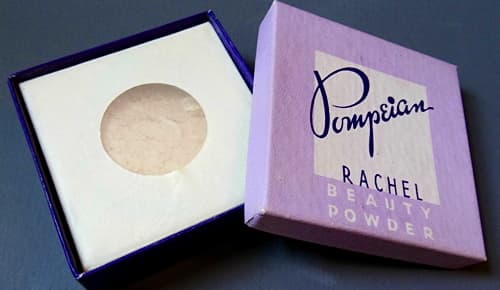
Above: c.1939 Pompeian Beauty Powder.
Eno was sold to was sold to Beecham Pills, Inc. in 1938 and the selling agents for Pompeian then passed to Prichard & Constance (Mfg) Ltd. It would appear that they also manufactured Pompeian products from their base in High Holborn, London. The products appear to have survived the Second World War but not for long with Pompeian Co. Ltd. (U.K.) being liquidated in 1950.
In the United States, Laco Products continued to promote Pompeian Milk Massage Cream after the war and, in an attempt to make it a blemish cream they had added hexachlorophene by 1951.
See also: Hexachlorophene
Pompeian Milk Massage Cream was still around when Divex, Inc. acquired Laco Products in 1967 but does not appear to have survived for long after this thus marking the end of a once illustrious brand.
Timeline
| 1892 | Fred Stecher takes a half share in his brother’s pharmacy business. |
| 1901 | Pompeian Massage Cream developed. |
| 1902 | Retail sales of Pompeian Massage Cream begin. |
| 1904 | Stecher becomes the inaugural president of the Barber’s Supply Dealers Association. |
| 1905 | Pompeian Manufacturing Company incorporates. |
| 1906 | Stecher moved his business to a new storefront on Fourth Street in downtown Cleveland. |
| 1915 | New Products: Pompeian Night Cream. |
| 1916 | Fred Stecher dies of heart disease and Otto Leopold becomes President of the company. New Products: Pompeian Hair Massage. |
| 1917 | New Products: Pompeian Beauty Powder; Pompeian Bloom; and Pompeian Day Cream. |
| 1919 | New Products: Pompeian Fragrance (Talcum Powder). |
| 1920 | John Ellis & Co. appointed distribution agents in the United Kingdom. |
| 1923 | New Products: Nymfaun line. Madame Jeanette begins providing beauty advice. |
| 1926 | Nymfaun, Inc. sold to Storfer Laboratories. |
| 1927 | Pompeian sold to Colgate & Company. |
| 1928 | Colgate amalgamates with Palmolive-Peet to form Colgate-Palmolive-Peet. |
| 1930 | Pompeian sold to a consortium. Renamed as The Pompeian Company, Inc. J. C. Eno takes over the distribution of Pompeian in Great Britain. |
| 1931 | New Products: Pompeian Dusting Powder. |
| 1935 | Pompeian introduces a new line and scraps the old one. Packaged in new black and red design. New Products: Pompeian Beauty Powder; Pompeian Cream Rouge; Pompeian Dry Rouge; Pompeian Lipstick; Pompeian Cleansing Cream; Pompeian Liquefying Cream; Pompeian Tissue Cream; and Pompeian Astringent and Skin Toner. |
| 1936 | Offices moved from Emira, New York to Bloomfield, New Jersey. |
| 1937 | The Pompeian Co. Ltd. established in Britain. U.S. Pompeian sold to Laco Products, Inc. |
| 1950 | The Pompeian Co. Ltd. (U.K.) liquidated. |
| 1967 | Divex, Inc. acquires Laco Products, Inc. |
First Posted: 21st July 2011
Last Update: 16th March 2022
Sources
Adkins, H. W. (1935). Pompeian’s new line. The Drug and Cosmetic Industry. 36(6). 711, 739.
Harry, R. G. (1973). Harry’s cosmeticology. (6th ed.). London: Leonard Hill Books.
Peiss, K. (2007). Hope in a jar: The making of America’s beauty culture. New York: Henry Holt and Company.
The Rise of Pompeian – How a pink face cream became a million dollar business. (2011, February 22). Retrieved June 22, 2011, from http://collectingvintagecompacts.blogspot.com/2011/02/rise-of-pompeian-how-pink-face-cream.html
The Fall of Pompeian – Not the Eruption of Vesuvius but Just as Final. (2011, April 19). Retrieved June 22, 2011, from http://collectingvintagecompacts.blogspot.com/2011/04/fall-of-pompeian-not-eruption-of.html
Thomssen, B. S. (1947). Modern cosmetics (3rd ed.). New York: Drug & Cosmetic Industry.

Fred W. Stecher [1866-1916].
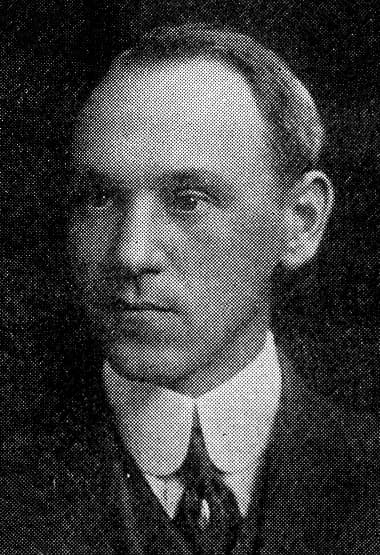
Otto F. Leopold [1883-1946].
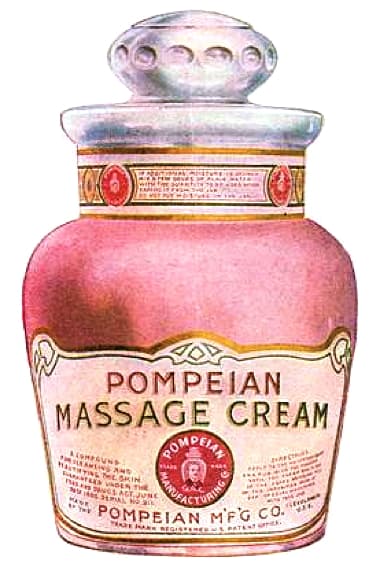
Pompeian Massage Cream.
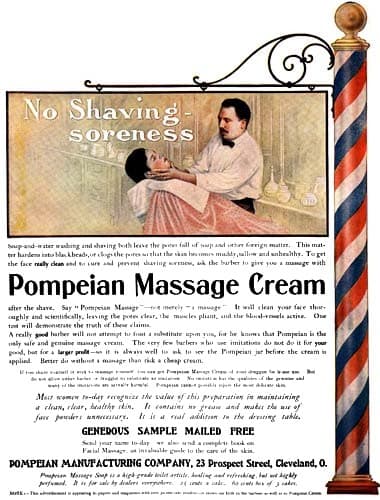
1907 Pompeian Massage Cream
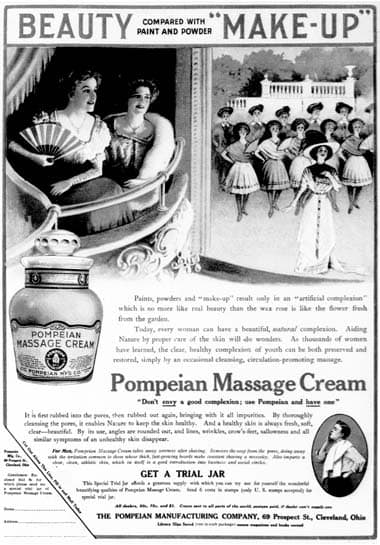
1909 Pompeian Massage Cream. Pompeian would give up condeming make-up once it got into the business as well.
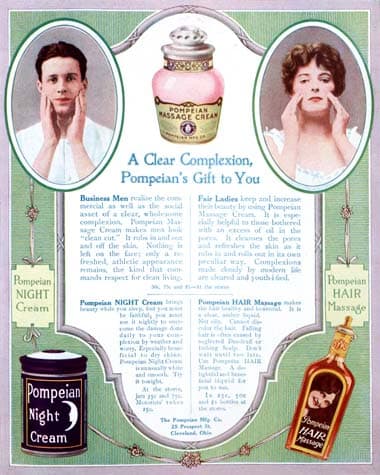
1916 Pompeian Night Cream and Pompeian Hair Massage
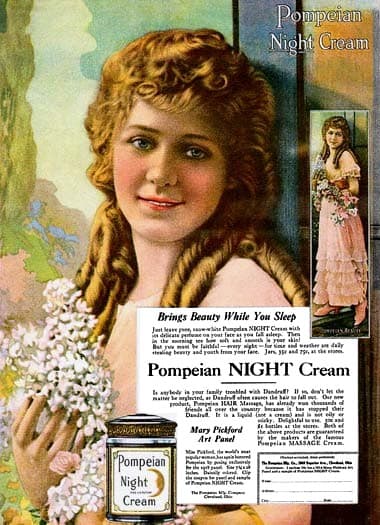
1916 Mary Pickford advertising Pompeian Night Cream.

1920 Pompeian Fragrance first introduced in 1919 as was the new typeface. Also showing Pompeian Beauty Powder, Day Cream and Bloom.
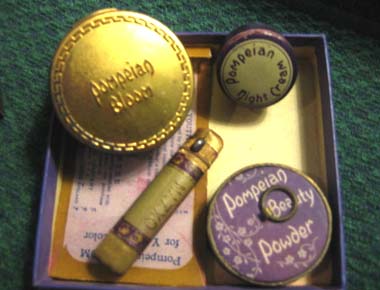
A selection of early Pompeian products from the 1920s.
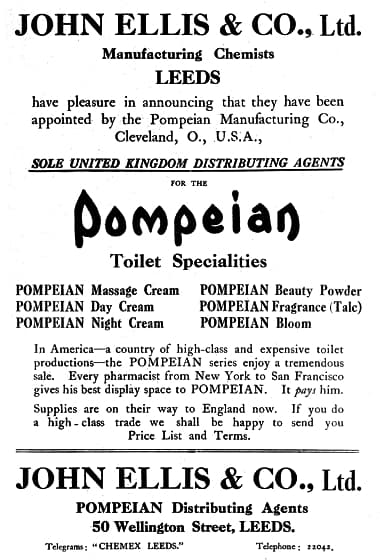
1920 Trade announcement by John Ellis (UK).

1922 New Pompeian Massage Cream jar for men.
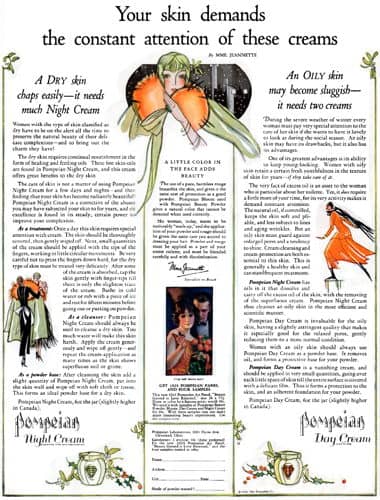
1924 Pompeian Night and Day Creams.
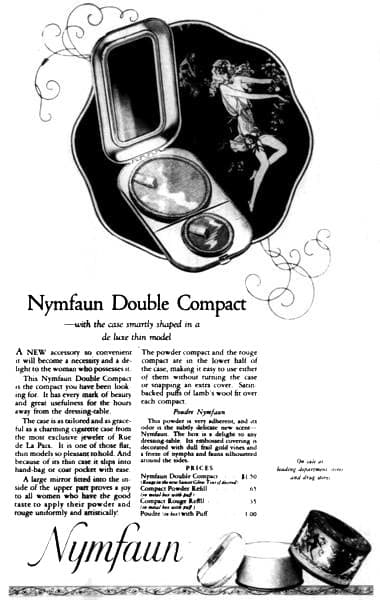
1924 Nymfaun. The cardboard powder and rouge boxes were decorated with white nymphs dancing with black fauns against a red background.
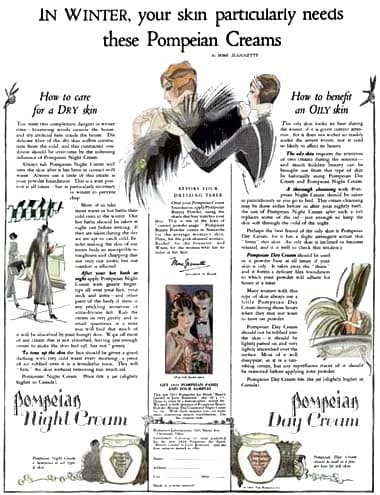
1925 Night and Day Creams with beauty advice from Madame Jeanette on how to care for your dry or oily skin during winter.
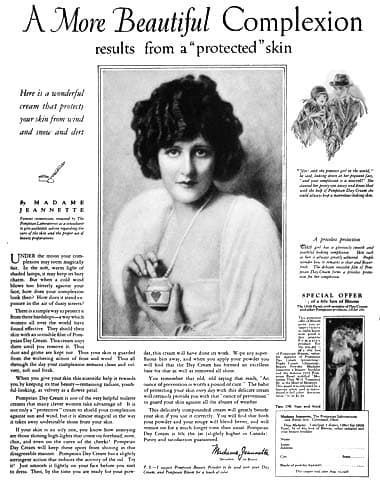
1926 A more beautiful complexion results from a ‘protected skin’ with beauty advice from Madame Jeanette.
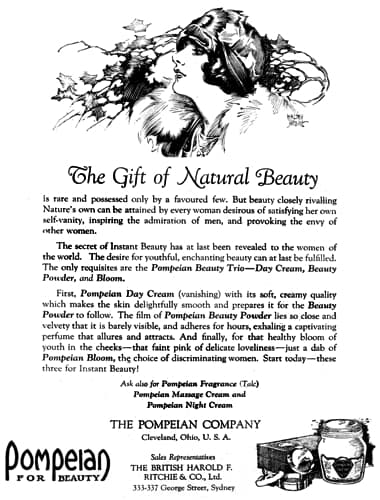
1926 Pompeian (Australia). The massage cream had been available there since 1906 at least.

1927 Pompeian Beauty Powder and Bloom for blondes.

1927 Pompeian Beauty Powder and Bloom for brunettes.
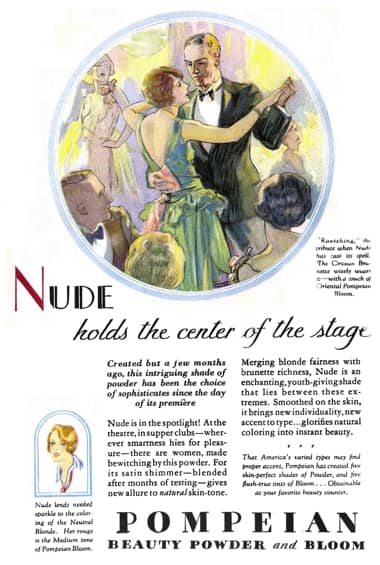
1928 Pompeian Nude Beauty Powder and Bloom.
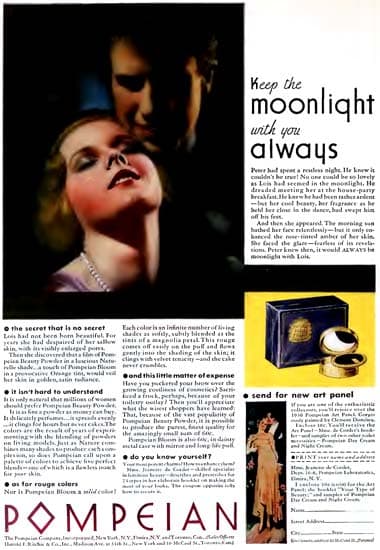
1930 Pompeian Beauty Powder and Bloom.

1930 Trade announcement by J. C. Eno (UK).

1932 Pompeian Beauty Powder.

1935 New Pompeian. The advertisement stresses the made up disease ‘Dermerosion’ the symptoms of which were dryness caused by zinc oxide in powders, enlarged pores from powders containing starch, blotches produced by powders with bismuth, and scaliness from zinc chloride in astringents.
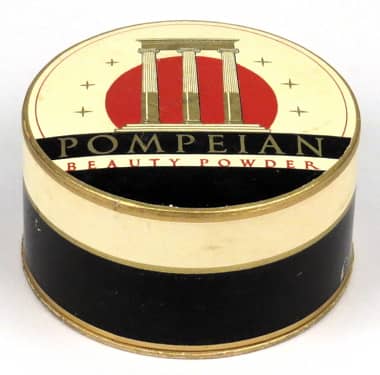
Pompeian Face Powder in the new packaging used after 1935 (Smithsonian).
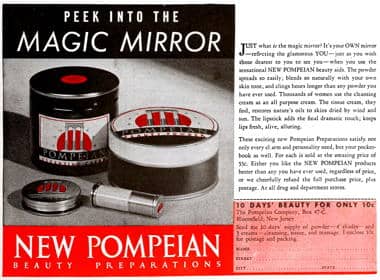
1936 Pompeian Beauty Preparations in new packaging.
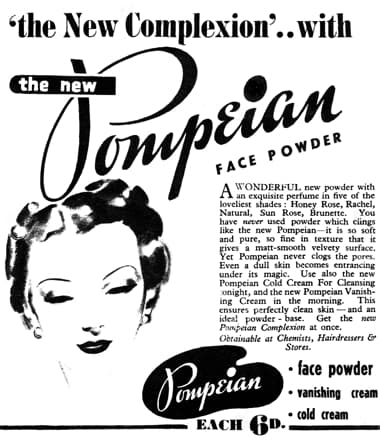
1939 Pompeian Face Powder, Cold Cream and Vanishing Cream (Britain).
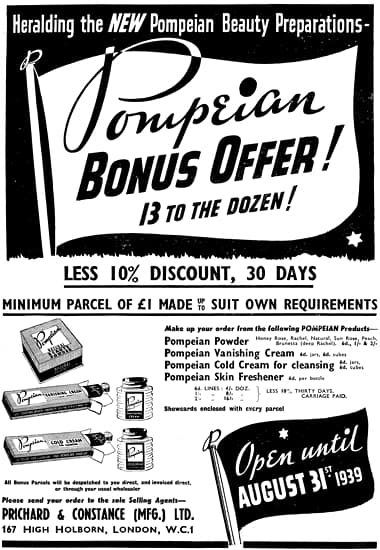
1939 Trade advertisment for Pompeian from Prichard & Constance (Manufacturing) Ltd. (Britain).
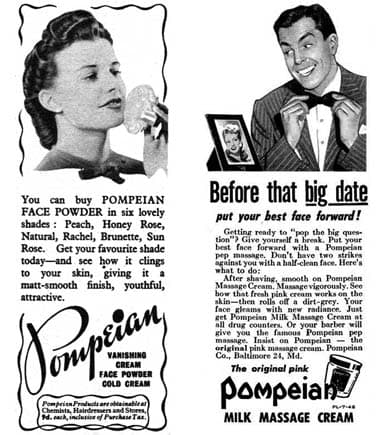
Two advertisements after Pompeian was sold to Laco Products. Left: 1943 Pompeian Face Powder, Vanishing Cream and Cold Cream. Right: 1946 Pompeian Milk Massage Cream.
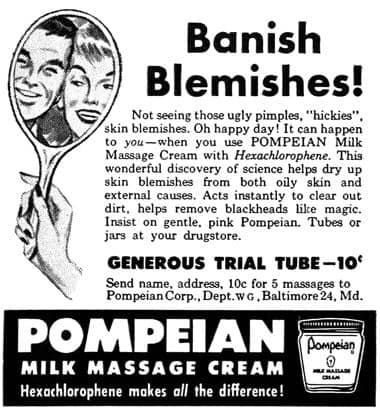
1958 Pompeian Milk Massage Cream with hexachlorophene.
